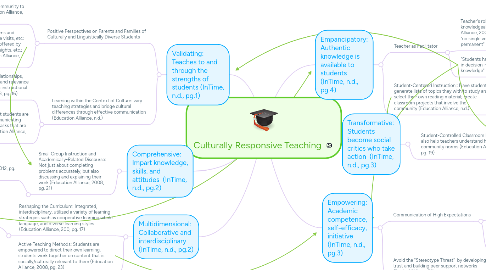
1. Validating: Teaches to and through the strengths of students (InTime, n.d., pg.1)
1.1. Positive Perspectives on Parents and Families of Culturally and Linguistically Diverse Students
1.1.1. Ongoing dialog with families and community to stay engaged and relevant (Education Alliance, 2008, pg. 25)
1.1.2. Understand parents' hopes, concerns and suggestions through surveys, home visits, etc; keep parents apprised of services offered by the school via newsletters, family nights, etc.; gain cross-cultural skills (Education Alliance, n.d.)
1.2. Learning within the Context of Culture: vary teaching strategies and bridge cultural differences through effective communication (Education Alliance, n.d.)
1.2.1. Culturally Mediated Instruction: relationships, ways of representing information, and relevance to student's life is all considered in instructional planning (Education Alliance, 2008, pg. 16)
1.2.2. Cultural Sensitivity: Recognize that students are not blank slates, use ways of communicating that are familiar, themes/learning tasks that are interesting and meaningful (Education Alliance, 2008, pg. 14)
1.2.2.1. Ask students to share their names, how to pronounce them correctly, what they mean (Davis, 2012, pg. 60)
2. Comprehensive: Impart knowledge, skills, and attitudes (InTime, n.d., pg.2)
2.1. Small Group Instruction and Academically-Related Discourse: Not just about completing problems accurately, but also discussing and explaining their work (Education Alliance, 2008, pg. 21)
2.1.1. Call-and-Resnpose Rhythms (Davis, 2012, pg. 63)
3. Multidimensional: Collaborative and interdisciplinary (InTime, n.d., pg.2)
3.1. Reshaping the Curriculum: Integrated, interdisciplinary, utilized a variety of learning strategies such as cooperative learning,whole language, and diverse learning styles (Education Alliance, 200, pg. 17)
3.1.1. Use resources rather than textbooks for study (Education Alliance, n.d.)
3.2. Active Teaching Methods: Students are empowered to direct their own learning, students work together on content that is socially/culturally relevant to them (Education Alliance, 2008, pg. 23)
4. Empancipatory: Authentic knowledge is available to students (InTime, n.d., pg.4)
4.1. Teacher as Facilitator
4.1.1. Teacher's role is one of guide, mediator, and knowledgeable consultant (Education Alliance, 2008, pg,12); acknowledging that "no single version of truth is total and permanent" (InTime, n.d., pg. 4)
4.1.2. "Students have a voice in the classroom, a share in decision-making and in the construction of knowledge" (Education Alliance, 2008, pg. 12)
4.2. Student-Centered Instruction:: Have students generate lists of topics they with to study and select their own reading material; create classroom projects that involve the community (Education Alliance, n.d.)
5. Transformative: Students become social critics who take action (InTime, n.d., pg.3)
5.1. Student-Controlled Classroom Discourse: can also help teachers understand home and community norms (Education Alliance, 2008, pg. 19)
5.1.1. Learning nonverbal cues and slang shows we care and lets them act as the experts (Davis, 2012, pg. 63)
6. Empowering: Academic competence, self-efficacy, initiative (InTime, n.d., pg.3)
6.1. Communication of High Expectations
6.1.1. Calling on students frequently to show their work and explain their processes to others; giving ample feedback/praise; de-tracking and offering challenging curriculum; providing intensive time on task (Education Alliance, 2008, pg. 10)
6.1.2. Clear expectations communicated by everyone (teachers, guidance counselors, administrators, etc) -> instrinsic motivation (Education Alliance, n.d.)
